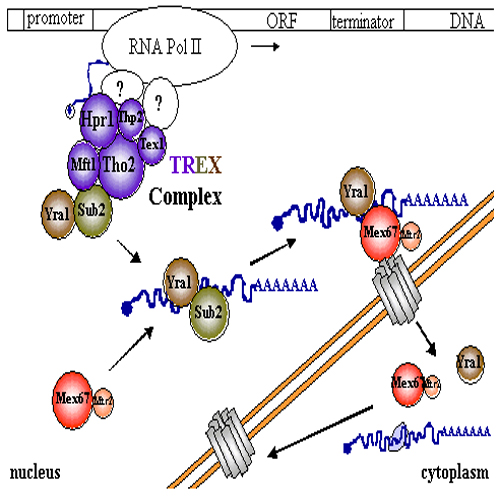YEAH! CIPSM-Junior-Group Leader Katja Strässer receives big €-EU-Grant
19-Aug-2008
2008, published on 19.08.2008
ERC
ERC
CIPSM-Junior-Group Leader Katja Sträßer has done it! She received a grant of nearly one million Euros from the European Research Council for the next five years. She will explore the understanding of a new aspect of how genetic information is read out by a cell. Many of the individual steps examined separately in the past are coupled with each other to allow for highly efficient regulation and control of gene expression. Searching for the Builder of the Bridge from Gene to Protein The European Research Council (ERC) promotes pioneering basic research by supporting excellent and unusually creative scientists. CIPSM-Junior-Group Leader Dr. Katja Sträßer from the Gene Center at Ludwig-Maximilians-Universität (LMU) München successfully took part in the “ERC Starting Grant Scheme”, a new EU program for junior scientists. Dr. Sträßer is one of only 300 applicants whose projects were selected from among 10,000 project proposals throughout Europe. Sträßer will now receive about one million Euros over the next five years. The biologist’s research elucidates the mechanisms of gene expression or, in other words, the conversion of genetic information into proteins. Genes are sections of DNA, the molecule that governs heredity and contains the “blueprint” for building proteins. “What interests me most is how the individual steps of the gene expression are coupled,” explains Sträßer, “The reason being that this explains how the conversion of genetic information is controlled and regulated.” In a past project she was able to demonstrate that the Ctk1 protein plays a role during different temporally as well as spatially separated phases of gene expression. In the newly funded project she therefore intends to examine the function of this molecule more closely and identify other factors that connect different steps of gene expression. The individual steps of gene expression are already well understood. The coupling of these different steps, however, is a completely new mechanism for regulation – and also occurs in humans. In higher organisms, gene expression entails a variety of different steps: First, during transcription the genetic information is copied into an RNA molecule. RNA is a nucleic acid chemically similar to DNA. This messenger RNA or mRNA is then processed, that is chemically altered, and packaged by different proteins in a complex that is then exported out of the nucleus. Within the cell interior or cytoplasm, the genetic information contained within the mRNA is finally converted into a protein during translation. “These processes, which are for the most part temporally and spatially separated, are already well understood,” explains Sträßer. “Only in recent years, it has been shown that some of these processes do not operate independently of each other but are interconnected.” This is especially true for processes that take place in the nucleus or in cytoplasm. The main objective of the newly funded project is to demonstrate a coupling of spatially separate processes or, more specifically, the coupling of transcription to translation.” A first step in this direction is already taken: Sträßer recently demonstrated that one well-known protein mediates such a wide-ranging coupling. The Ctk1 protein in yeast ensures that transcription is not prematurely terminated and also plays an important role in the processing of the mRNA. “We demonstrated that Ctk1 interacts with the TREX complex, which couples transcription with the nuclear export of the mRNA,” reports the biologist. “Our new results show that Ctk1 is also important for efficient translation or, in other words, for the synthesis of proteins in the cytoplasm. It is highly likely that the human counterpart of Ctk1, namely the CDK9 protein, also performs this very surprising function. We suspect that Ctk1 binds to the mRNA after the mRNA is processed and is transported to the cytoplasm along with the mRNA where it can then enhance translation.” This protein would therefore be one of the first examples of a connection between gene expression processes taking place in the nucleus and the cytoplasm. One objective of the planned project is therefore a detailed analysis of the various functions of Ctk1. Furthermore, additional factors with a similarly broad range of functions in gene expression shall be identified. Sträßer is also interested in ribosomes, large complexes made up of proteins and nucleic acids. Ribosomes are responsible for the synthesis of the encoded proteins using mRNAs as a template. “We want to examine how and which ribosomal proteins are chemically modified and which factors participate in this process,” explains Sträßer. “These modifications are important for the regulation of many cellular processes. Yet to date very little is known about the modification of ribosomes, which are so important for protein synthesis. This makes the modifications alone a very exciting object to study. In addition, these modifications could also be important for the coupling of translation with transcription. Finally, we will examine whether our results obtained with the yeast S. cerevisiae as a model system also hold true for mammal cells. Thus, we aim to identify mechanisms that connect gene expression processes in nucleus and cytoplasm in all higher organisms.” Since January 2003, Dr. Katja Sträßer is the head of an independent research group at the Gene Center at LMU Munich. The 36-year-old biotechnologist received the prestigious EMBO Young Investigator Award in 2004 and the “Habilitation” Prize of the Dr. Klaus Römer Endowment at the LMU Department of Chemistry and Biochemistry in 2007. The ERC's decision was solely based on the scientific excellence of the applicant and the proposed project. Projects eligible for funding must be highly innovative – risky but, when successful, opening new and important scientific horizons. The project is expected to involve cooperations as well as a high degree of interdisciplinarity. This EU program for the advancement of basic research was established in 2007.











